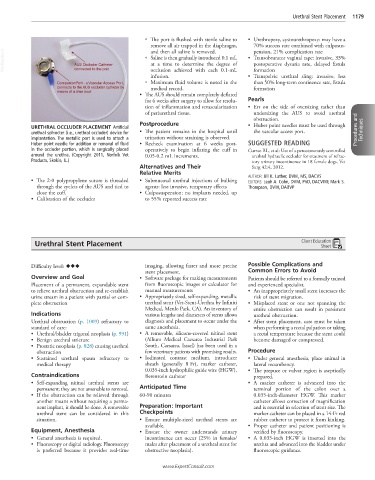Page 2385 - Cote clinical veterinary advisor dogs and cats 4th
P. 2385
Urethral Stent Placement 1179
○ The port is flushed with sterile saline to • Urethropexy, cystourethropexy: may have a
remove all air trapped in the diaphragm, 70% success rate combined with culposus-
VetBooks.ir AUS Occluder Catheter ○ Saline is then gradually introduced 0.1 mL • Transobturator vaginal tape: invasive, 33%
pension, 21% complication rate
and then all saline is removed.
postoperative dysuria rate, delayed fistula
at a time to determine the degree of
formation
occlusion achieved with each 0.1-mL
connected to the port
infusion. • Transpelvic urethral sling: invasive, less
CompanionPort - a Vascular Access Port, ○ Maximum fluid volume is noted in the than 50% long-term continence rate, fistula
connects to the AUS occluder catheter by medical record. formation
means of a blue boot
• The AUS should remain completely deflated
for 6 weeks after surgery to allow for resolu- Pearls
tion of inflammation and revascularization • Err on the side of oversizing rather than
of periurethral tissue. undersizing the AUS to avoid urethral
obstruction.
Postprocedure • Huber point needles must be used through
URETHRAL OCCLUDER PLACEMENT Artificial Procedures and
urethral sphincter (i.e., urethral occluder) device for • The patient remains in the hospital until the vascular access port. Techniques
implantation. The metallic port is used to attach a urination without straining is observed.
Huber point needle for addition or removal of fluid • Recheck examination at 6 weeks post- SUGGESTED READING
in the occluder portion, which is surgically placed operatively to begin inflating the cuff in Currao RL, et al: Use of a percutaneously controlled
around the urethra. (Copyright 2011, Norfolk Vet 0.05-0.2 mL increments. urethral hydraulic occluder for treatment of refrac-
Products, Skokie, IL.) tory urinary incontinence in 18 female dogs. Vet
Alternatives and Their Surg 42:4, 2012.
Relative Merits
• The 2-0 polypropylene suture is threaded • Submucosal urethral injections of bulking AUTHOR: Jill K. Luther, DVM, MS, DACVS
EDITORS: Leah A. Cohn, DVM, PhD, DACVIM; Mark S.
through the eyelets of the AUS and tied to agents: less invasive, temporary effects Thompson, DVM, DABVP
close the cuff. • Culposuspension: no implants needed, up
• Calibration of the occluder to 55% reported success rate
Urethral Stent Placement Client Education
Sheet
Difficulty level: ♦♦♦ imaging, allowing faster and more precise Possible Complications and
stent placement. Common Errors to Avoid
Overview and Goal • Software package for making measurements Patients should be referred to a formally trained
Placement of a permanent, expandable stent from fluoroscopic images or calculator for and experienced specialist.
to relieve urethral obstruction and re-establish manual measurements • An inappropriately small stent increases the
urine stream in a patient with partial or com- • Appropriately sized, self-expanding, metallic risk of stent migration.
plete obstruction urethral stent (Vet-Stent-Urethra by Infiniti • Misplaced stent or one not spanning the
Medical, Menlo Park, CA). An inventory of entire obstruction can result in persistent
Indications various lengths and diameters of stents allows urethral obstruction.
Urethral obstruction (p. 1009) refractory to diagnosis and placement to occur under the • After stent placement, care must be taken
standard of care: same anesthesia. when performing a rectal palpation or taking
• Urethral/bladder trigonal neoplasia (p. 991) • A removable, silicone-covered nitinol stent a rectal temperature because the stent could
• Benign urethral stricture (Allium Medical Caesarea Industrial Park become damaged or compressed.
• Prostatic neoplasia (p. 828) causing urethral South, Caesarea, Israel) has been used in a
obstruction few veterinary patients with promising results. Procedure
• Sustained urethral spasm refractory to • Iodinated contrast medium, introducer • Under general anesthesia, place animal in
medical therapy sheath (generally 8 Fr), marker catheter, lateral recumbency.
0.035-inch hydrophilic guide wire (HGW), • The prepuce or vulvar region is aseptically
Contraindications Berenstein catheter prepared.
• Self-expanding nitinol urethral stents are • A marker catheter is advanced into the
permanent; they are not amenable to removal. Anticipated Time terminal portion of the colon over a
• If the obstruction can be relieved through 60-90 minutes 0.035-inch-diameter HGW. This marker
another means without requiring a perma- catheter allows correction of magnification
nent implant, it should be done. A removable Preparation: Important and is essential in selection of stent size. The
urethral stent can be considered in this Checkpoints marker catheter can be placed in a 14-Fr red
situation. • Ensure multiple-sized urethral stents are rubber catheter to protect it from kinking.
available. • Proper catheter and patient positioning is
Equipment, Anesthesia • Ensure the owner understands urinary verified by fluoroscopy.
• General anesthesia is required. incontinence can occur (25% in females/ • A 0.035-inch HGW is inserted into the
• Fluoroscopy or digital radiology. Fluoroscopy males after placement of a urethral stent for urethra and advanced into the bladder under
is preferred because it provides real-time obstructive neoplasia). fluoroscopic guidance.
www.ExpertConsult.com

